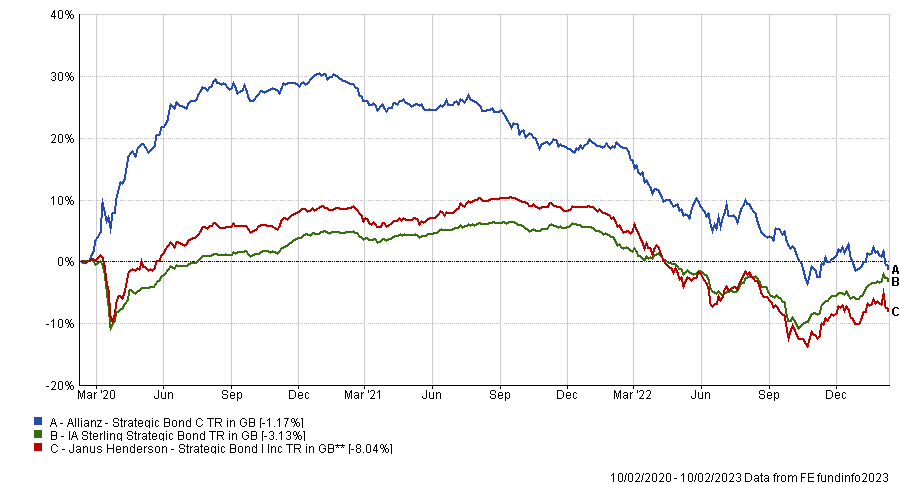After the hefty drop in bonds prices and the subsequent sell-off of 2022, outlooks have become more and more optimistic for the bonds, with investors not wanting to miss out on the potential recovery. But deciding on a fixed-income allocation is not easy in 2023, especially in the much-diverse IA Sterling Strategic Bond sector.
Below, we asked four experts for their opinions on the Allianz and Janus Henderson strategic bond funds, which, with £2.2bn and £2.9bn of assets under management respectively, are among the largest and most popular funds in the sector.
The managers, Allianz’ Mike Riddell and Henderson’s Jenna Barnard and John Pattullo, take an active approach for their portfolios, which results in a clear differentiation from the fixed interest asset class and from more benchmark-aware peers.
But the investment processes differ, with the former being usually appreciated for its low correlation to equities and its macro approach, and the latter for its focus on corporate bonds and fundamentals. Which one is better positioned going forward?
Performance of funds over 3yrs against sector

Source: FE Analytics
Given the active nature of these portfolios, periods of underperformance or outperformance can occur according to whether the managers make correct assessments of the macro-economic environment and its impact on various areas of the fixed income spectrum, said Rob Morgan, chief analyst at Charles Stanley, whose preference went to Janus Henderson Strategic Bond.
“The return profile has been more consistent over time, with one stellar period for the Allianz fund in 2020 skewing its past performance numbers. This makes the Janus Henderson fund a more appropriate core option in the fixed interest space,” he said.
“The managers are naturally conservative and tend to add value more incrementally through solid credit selection as well as allocating between fixed income areas. Decision making is nimble, a key benefit of a small team, but is supported by a very large and well-resourced credit research function, which is the best of both worlds for a product such as this.”
Ben Yearsley, director at Fairview Investing, went for Allianz instead and would only choose Janus Henderson’s fund if it was the only bond fund in your portfolio.
“Janus Henderson Strategic Bond is a more vanilla strategic bond fund that isn’t trying to be too clever,” he said.
“If you are buying as part of a portfolio of funds where you want to take different risks, my answer is to use Allianz Strategic Bond. It’s quite a distinct fund, offering something very different to most mainstream bond funds”.
Kelly Prior, investment manager in the multi-manager team at Columbia Threadneedle Investments, agreed that Allianz might be in a good position for its commitment to its views, whereas others are having to re-route.
“Riddell’s team believes in backing its judgement and is most comfortable when positioned away from consensus. To that end now is an interesting time given their deep recession stance, which has not worked so well recently, but may yet bear fruit while others row back on the narrative that just a month ago was all the rage,” she said.
“On the other hand, the Janus team are value investors but also analysts at heart. This is reflected in the quality investment grade cash bond element that has sat behind other assets offering carry to smooth returns for the majority of the fund life. If we were to enter a more macro environment, something difficult to envisage right now, this team may arguably have more to offer.”
Prior’s favourite, however, would very much depend on what is held alongside each fund and tolerance for volatility, as Henderson has “historically smoothed the return profile, but at the cost of the strong rallies that Allianz has enjoyed when it has called the macro right”.
Lastly, Sheridan Admans, head of fund selection at TILLIT, noted that the two funds are currently positioned following two very different views of the current macroeconomic environment and the choice for the investor would depend on whose view they agree with.
The Janus Henderson Strategic Bond consists of approximately 50% held in government bond issues (the most overweight the fund has been in the past three years) and the balance held in commercial issues, while the Allianz Strategic Bond fund is approximately 90% exposed to safe-haven government bonds and 10% to money market instruments (or very short-dated bond issues).
Additionally, Allianz has 72% held in AAA issues (the highest quality paper) as opposed to Janus Henderson which has 32%. Janus Henderson has 12% exposure to UK Gilts and Allianz has none to speak of.
“The funds and their managers have quite different views and approaches to delivering outcomes for investors. The Allianz Strategic Bond is positioned for another significant global macro turning point event, while the Janus Henderson fund is positioned for the global economy heading for a synchronized long-drawn downturn,” said Admans.
“Over the long term, the choice is more dependent on what an investor needs from their bond fund allocation and how that fits with the overall asset allocation of their portfolio.”




